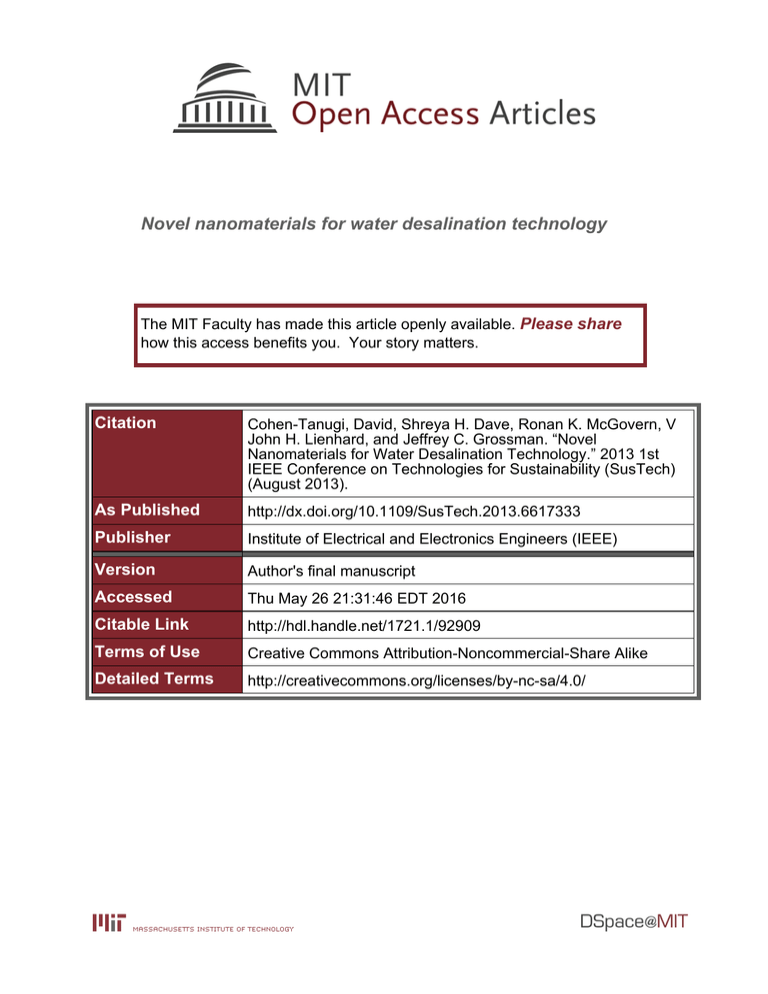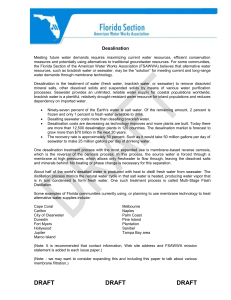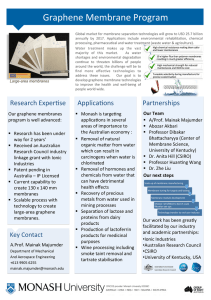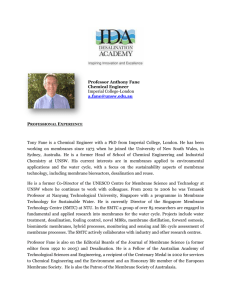Novel nanomaterials for water desalination technology Please share
advertisement

Novel nanomaterials for water desalination technology The MIT Faculty has made this article openly available. Please share how this access benefits you. Your story matters. Citation Cohen-Tanugi, David, Shreya H. Dave, Ronan K. McGovern, V John H. Lienhard, and Jeffrey C. Grossman. “Novel Nanomaterials for Water Desalination Technology.” 2013 1st IEEE Conference on Technologies for Sustainability (SusTech) (August 2013). As Published http://dx.doi.org/10.1109/SusTech.2013.6617333 Publisher Institute of Electrical and Electronics Engineers (IEEE) Version Author's final manuscript Accessed Thu May 26 21:31:46 EDT 2016 Citable Link http://hdl.handle.net/1721.1/92909 Terms of Use Creative Commons Attribution-Noncommercial-Share Alike Detailed Terms http://creativecommons.org/licenses/by-nc-sa/4.0/ Novel nanomaterials for water desalination technology David Cohen-Tanugi Massachusetts Institute of Technology Department of Materials Science & Engineering Cambridge MA 02139 dctanugi@mit.edu Shreya H. Dave Massachusetts Institute of Technology Department of Materials Science & Engineering Cambridge MA 02139 Ronan K. McGovern Massachusetts Institute of Technology Department of Mechanical Engineering Cambridge MA 02139 John H. Lienhard V Massachusetts Institute of Technology Department of Mechanical Engineering Cambridge MA 02139 Jeffrey C. Grossman Massachusetts Institute of Technology Department of Materials Science & Engineering Cambridge MA 02139 Abstract— Water desalination has a central role to play in the global challenge for sustainable water supply in the 21st century. But while the membranes employed in reverse osmosis (RO) have benefited from substantial improvements over the past 25 years, several recent advances in materials suggest that new membranes with dramatically higher water permeability will become available in the future. After providing an overview of the importance of membranes for sustainable water production, we describe some of the most exciting novel approaches for water desalination based on nanomaterials. In particular, graphene, a single-layer sheet of carbon with remarkable mechanical and electronic properties, can be patterned with nanometer-sized pores, to act as an ultra-thin filtration membrane. Drawing from our group’s research at MIT, we will share some of our key findings about the potential impact of nanomaterials as membranes for water desalination in the 21st century. Keywords— water, desalination, graphene, materials, sustainability, reverse osmosis, throughput, ultra-permeable membranes, I. INTRODUCTION As water resources worldwide become rapidly scarcer, it is crucial to devise new techniques to obtain clean water from seawater. At present, water purification technologies are limited by costly energy requirements relative to the theoretical thermodynamic minimum and the limitations of current technology. New advances in experimental and computational materials science offer us a way to investigate saltwater transport across a membrane with a degree of precision and insight that was simply not achievable in the past. II. BACKGROUND Fresh water is becoming an increasingly scarce global resource, and its availability is expected to determine the long-term wealth of nations and the wellbeing and happiness of their people [1]. Water desalination provides the attractive possibility of expanding the natural hydrological cycle by supplementing it with formerly inaccessible sources such as oceans and brackish reservoirs. Although desalination has been successfully implemented globally, this success often comes at a high cost. For example, the reverse osmosis plant that supplies water for the Spanish province of Almeria requires a full third of the province’s electricity [2]. Meanwhile, more efficient plants are expensive to build and may occupy large areas in coastal zones where land is increasingly limited. The most efficient plants desalinate water using reverse osmosis (RO), a process that involves pushing the saline water across semi-permeable membranes at high pressure. The energy intensity of desalinated water from reverse osmosis is often considered a major barrier to its cost and scalability, though the energy use per cubic meter of fresh water has decreased from 8 to 1.8 kWh from 1980 to today. Some experts suggest that opportunities for efficiency improvements in the RO process are limited, and that desalinated water will always remain an expensive solution to global water crises [3]. III. THE MEMBRANES OF TOMORROW Todays’ thin-film composite (TFC) membranes, made primarily from polyamide, achieve very high salt rejection (> 99%), but at the expense of a low permeability to water. Unfortunately, the prevailing design of membranes has not changed significantly since the 1970s. Nanoporous materials have a great deal to offer over existing technologies for desalination [4]. In contrast with classical RO membranes, where water transports slowly via a solutiondiffusion process, nanoporous membranes can allow for fast convective water flow across well-defined channels. Thanks to their small dimensions, nanopores can be used as filters on the basis of molecular size, since small molecules can pass through them while larger ones cannot. And because the dimensions of the nanopores are also comparable to the Debye screening length for electrostatic interactions and smaller than the mean free path between molecular collisions in water, the pores can also make use of other physical principles – such as charge or hydrophobicity – to reject ions or other molecular solutes. These same principles may also be at play in conventional TFC membranes, but the design of nanoporous membranes might allow for even better control of the associated material and chemical properties. Nanofluidics studies of synthetic nanostructures such as carbon nanotubes (CNTs) suggest that water inside such structures can exhibit ‘hyperlubricity’ and flow at rates greater than predicted by continuum fluid dynamics[5]. Metal-organic frameworks (MOFs) such as zeolites have also been examined for desalination technology[6]. However, to date none of these nanomaterials have proved successful for desalination. Membranes based on CNTs have been limited by low salt rejection rates and the difficulty of producing highly aligned and high-density CNT arrays [7], [8]. As for zeolites, studies suggest that their relatively low water permeability may pose a challenge for desalination applications [9]. IV. NANOPOROUS GRAPHENE AS A MEMBRANE We describe a new approach for water desalination based on nanoporous graphene. This approach represents a promising step towards addressing global water scarcity in an energyefficient manner. By introducing nanoscale pores in the structure of a graphene layer, it becomes possible to use graphene as a filtration membrane, in order to effectively separate out salt ions and impurities and produce a clean water supply. Potential advantages of graphene over existing nanofiltration materials include negligible thickness (one atomic layer) and high mechanical strength, which may enable faster water transport and higher operating pressures than previously possible. Using Molecular Dynamics simulations, we have investigated the theoretical behavior of a saltwater-graphene system under applied pressure. We find that an effective size exclusion mechanism prevents Na+ and Cl- ions and their hydration shells from passing through the confining pores at sufficiently small pore diameters. The pore diameter and the chemical interactions at the water-membrane interface thus become the most important criteria for effective desalination performance. Figure 1: Molecular representation of nanoporous graphene membrane (center) rejecting a solvated salt ion (right, in green). Water that passes through the membrane is effectively free of salts, making nanoporous graphene a powerful and highly permeable membrane for RO. Our key results regarding the effect of system properties (pore morphology, surface chemistry, applied pressure, etc.) on desired performance characteristics such as ion selectivity, maximal water flux and energy requirements have been presented elsewhere [10]. V. REAL-WORLD IMPACTS correspondingly lower minimum work of separation for extracting pure water from the feed. By modeling the flow of feed water and its permeation across an RO membrane using governing fluid dynamics equations coded in Mathematica 9, we have estimated the pressure that would need to be applied to brackish water to achieve 65% recovery. For a conventional RO membrane, this pressure is around 15 bar. In contrast, a UPM with 15 L/m2-hr-bar would require a pressure of only about 6 bar to achieve the same recovery at a given feed velocity. Our methodology also allows us to estimate and visualize the evolution of the relevant physical quantities as a function of distance down the RO vessel (Figure 2). Ultra-permeable membranes (UPMs) could help reduce the cost and energy footprint of RO. In particular, we have looked at the potential impact of UPMs on the specific energy consumption of RO, the required operating pressure, the achievable water throughput, the recovery yield and the minimum pressure vessel length as a function of membrane permeability. We find that UPMs would add most value for brackish water from inland and underground sources. Thanks to its low salinity compared with seawater (~2,000 ppm), brackish water possesses a lower osmotic pressure and a FlowrateHzL Hm3 êdL 350 Pressure HbarL 25.0 300 24.8 250 200 24.6 150 24.4 100 24.2 50 0 0 1 2 3 4 5 6 7 24.0 0 1 2 3 4 5 Permeate fluxHzL HmêdL RecoveryHzL 6 5 LêHm2 hr barL 7 15 LêHm2 hr barL 7 0.8 6 5 0.6 4 0.4 3 2 0.2 0.0 1 0 1 2 3 4 5 6 7 0 0 1 2 3 4 5 6 7 Figure 2: Physical profile of feed channel flowrate, hydraulic pressure, cumulative recovery and feed salinity as a function of distance down a 6-element RO vessel for brackish water at 25 bar. The plots compare low (blue) and high (red) permeability membrane scenarios corresponding to 5 and 15 L/m2-hr-bar respectively. The permeate flux profile is steeper in the high permeability case, but the final recovery at the end of the module is limited by the applied pressure of the incoming feed water. These profiles suggest that lower pressure operation and higher throughput might be more effective uses of a UPM system than higher recovery in the case of brackish water. By increasing the feed water velocity inside more permeable membrane elements, an RO plant operator can obtain the same recovery ratio and apply the same pressure while producing more fresh per day than using conventional systems. The throughput per membrane element increases by as much as four-fold for seawater and three-fold for flowback water. In practice, this would allow for more compact desalination plants that would produce the same amount of fresh water per day but would require lower capital costs due to fewer RO vessels, piping, etc. Seawater H8-element vesselL 2.7 kWhêm3 0.4 Permeate recovery UPMs could also enable higher water throughput and correspondingly more compact RO systems in seawater (~42,000 ppm) and flowback water (>75,000 ppm). While these feed waters contain a significant concentration of salt and therefore leave more limited room for reductions in applied pressure, the operation of seawater or flowback water RO could be improved in other ways. 2.7 kWhêm3 2.7 kWhêm3 0.3 0.2 0.1 0.0 0 5 10 Permeability HLêHm2 hr barL 15 20 Figure 3: Recovery ratio achievable across an 8-element seawater RO vessel as a function of permeability, for a fixed reference pressure (70 bar) and feed flowrate (220 m3/day). The amount of permeate water recovered has an upper limit which is dictated by the applied pressure and the osmotic pressure of the brine, but the plot shows that more permeable membranes could help bring the recovery from 42% today up to this theoretical limit at about ~49%. The plot labels indicate the energy consumption remains unchanged at 2.7 kWh/m3 even at higher recovery. VI. OUTLOOK The evidence suggests that a bottom-up, systematic redesign of desalination membrane materials can yield significant improvements over existing technological methods. We expect that work in this field will add to the understanding of nextgeneration membranes for clean water technology. [4] [5] ACKNOWLEDGMENT We thank Drs. Joo-Hyoung Lee, Ateeque Malani, Francis O’Sullivan, Rick Stover, Prakash Govindan, Anurag Bajpayee and Alexie Kolpak for useful discussions. David Cohen-Tanugi was funded by the MIT Energy Initiative, the John S. Hennessy Fellowship and the National Science Foundation. This research was also partially funded by the MITei Seed Fund Program. Calculations were performed using NERSC computing resources. REFERENCES [1] [2] [3] F. Devoto, E. Duflo, P. Dupas, W. Pariente, and V. Pons, “Happiness on Tap: Piped Water Adoption in Urban Morocco,” NATIONAL BUREAU OF ECONOMIC RESEARCH, Cambridge MA, 16933, Apr. 2011. P. Dickie, “Desalination: option or distraction for a thirsty world?,” WWF Global Freshwater Programme, Jun. 2007. L. Addams, G. Boccaletti, M. Kerlin, M. Stuchtey, 2. W. R. [6] [7] [8] [9] [10] Group, McKinsey and Company, “Charting Our Water Future: Economic Frameworks to Inform Decision-making,” 2030 Water Resources Group, 2009. T. Humplik, J. Lee, S. C. O’Hern, B. A. Fellman, M. A. Baig, S. F. Hassan, M. A. Atieh, F. Rahman, T. Laoui, R. Karnik, and E. N. Wang, “Nanostructured materials for water desalination,” Nanotechnology, vol. 22, no. 29, p. 292001, Jun. 2011. A. Alexiadis and S. Kassinos, “Molecular Simulation of Water in Carbon Nanotubes,” Chem Rev, vol. 108, no. 12, pp. 5014–5034, 2008. M. M. Pendergast and E. M. V. Hoek, “A review of water treatment membrane nanotechnologies,” Energ Environ Sci, vol. 4, no. 6, pp. 1946–1971, 2011. F. Fornasiero, J. B. In, S. Kim, H. G. Park, Y. Wang, C. P. Grigoropoulos, A. Noy, and O. Bakajin, “pH-Tunable Ion Selectivity in Carbon Nanotube Pores,” Langmuir, vol. 26, no. 18, pp. 14848–14853, Sep. 2010. F. Fornasiero, H. G. Park, J. K. Holt, M. Stadermann, C. P. Grigoropoulos, A. Noy, and O. Bakajin, “Ion exclusion by sub-2nm carbon nanotube pores,” P Natl Acad Sci Usa, vol. 105, no. 45, pp. 17250–17255, 2008. Z. Hu, Y. Chen, and J. Jiang, “Zeolitic imidazolate framework-8 as a reverse osmosis membrane for water desalination: Insight from molecular simulation,” J Chem Phys, vol. 134, no. 13, p. 134705, 2011. D. Cohen-Tanugi and J. C. Grossman, “Water Desalination across Nanoporous Graphene,” Nano Letters, vol. 12, no. 7, pp. 3602– 3608, 2012.





